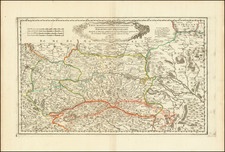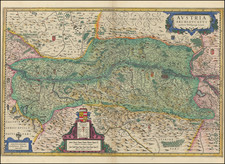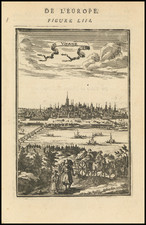Like The Monsters of Homer's Odyssey
Georg Braun and Frans Hogenberg's two-part view, titled Cataractae Danubii Vulgo Strudl et Werbl. Duo Loca Periculosae Inter Imsum Superis et Cremsium Inferioris Austriae, provides an informative illustration of a portion of the Danube River.
The detailed image depicts two sections of the river known for its swift currents and tumultuous conditions. Scylla and Charybdis mentioned in the title refer to the monsters from the Odyssey, who live on both sides of a strait.
The focus of the image is the river itself, shown flowing through a rugged, mountainous landscape. The river's course at this point is characterized by white-water rapids and whirlpools. These terms indicate the rough conditions created by the river's fast-moving waters against the rocky river bed, contributing to the difficulty of navigation in this section.
The Danube is shown running between high cliffs on either side, presenting a visually impressive natural landscape. The cliffs are predominantly rocky and covered in green vegetation, which adds color and texture to the image. Protruding rocky outcrops interrupt the line of the cliffs, indicating the river's winding course.
Boats of different sizes are shown on the river, demonstrating its use as a transport route despite the challenging conditions. Some boats appear to be caught in the whirlpools, indicating the difficulties encountered by river users.
Georg Braun (1541-1622) was born and died in Cologne. His primary vocation was as Catholic cleric; he spent thirty-seven years as canon and dean at the church St. Maria ad Gradus, in Cologne. Braun was the chief editor of the Civitates orbis terrarum, the greatest book of town views ever published. His job entailed hiring artists, acquiring source material for the maps and views, and writing the text. In this role, he was assisted by Abraham Ortelius. Braun lived into his 80s, and he was the only member of the original team to witness the publication of the sixth volume in 1617.
Frans Hogenberg (ca. 1540-ca. 1590) was a Flemish and German engraver and mapmaker who also painted. He was born in Mechelen, south of Antwerp, the son of wood engraver and etcher Nicolas Hogenberg. Together with his father, brother (Remigius), uncle, and cousins, Frans was one member of a prominent artistic family in the Netherlands.
During the 1550s, Frans worked in Antwerp with the famous mapmaker Abraham Ortelius. There, he engraved the maps for Ortelius’ groundbreaking first atlas, published in Antwerp in 1570, along with Johannes van Deotecum and Ambrosius and Ferdinand Arsenius. It is suspected he engraved the title page as well. Later, Ortelius supported Hogenberg with information for a different project, the Civitates orbis terrarium (edited by Georg Braun, engraved by Hogenberg, published in six volumes, Cologne, 1572-1617). Hogenberg engraved the majority of the work’s 546 prospects and views.
It is possible that Frans spent some time in England while fleeing from religious persecution, but he was living and working in Cologne by 1580. That is the city where he died around 1590. In addition to his maps, he is known for his historical allegories and portraits. His brother, Remigius, also went on to some fame as an engraver, and he died around the same time as his brother.









![[ Electors of the Holy Roman Empire ] Ordines Sacri Romani Imp: Ab Ottone III Instituti](https://storage.googleapis.com/raremaps/img/small/99053.jpg)
![[Vienna] Prospect und Grund Riss der Kayserl Residenz-Stadt Wien . . .](https://storage.googleapis.com/raremaps/img/small/81235.jpg)

![[The Danube in Roman Times]](https://storage.googleapis.com/raremaps/img/small/74010.jpg)

